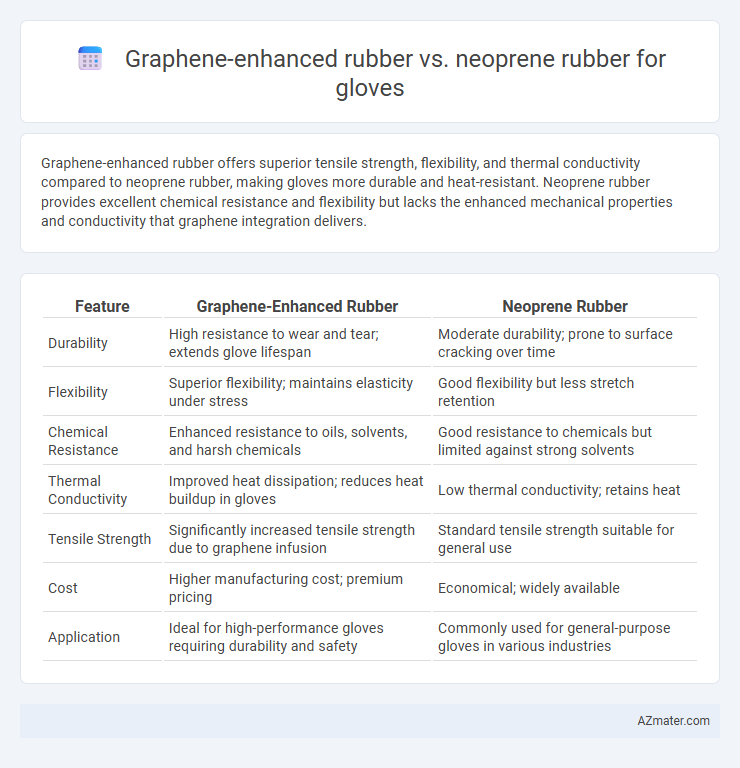Graphene-enhanced rubber offers superior tensile strength, flexibility, and thermal conductivity compared to neoprene rubber, making gloves more durable and heat-resistant. Neoprene rubber provides excellent chemical resistance and flexibility but lacks the enhanced mechanical properties and conductivity that graphene integration delivers.
Table of Comparison
| Feature | Graphene-Enhanced Rubber | Neoprene Rubber |
|---|---|---|
| Durability | High resistance to wear and tear; extends glove lifespan | Moderate durability; prone to surface cracking over time |
| Flexibility | Superior flexibility; maintains elasticity under stress | Good flexibility but less stretch retention |
| Chemical Resistance | Enhanced resistance to oils, solvents, and harsh chemicals | Good resistance to chemicals but limited against strong solvents |
| Thermal Conductivity | Improved heat dissipation; reduces heat buildup in gloves | Low thermal conductivity; retains heat |
| Tensile Strength | Significantly increased tensile strength due to graphene infusion | Standard tensile strength suitable for general use |
| Cost | Higher manufacturing cost; premium pricing | Economical; widely available |
| Application | Ideal for high-performance gloves requiring durability and safety | Commonly used for general-purpose gloves in various industries |
Introduction to Advanced Rubber Materials in Glove Manufacturing
Graphene-enhanced rubber significantly improves mechanical strength, flexibility, and chemical resistance compared to traditional neoprene rubber, making it an innovative choice in glove manufacturing. The incorporation of graphene nanoparticles enhances durability and elasticity, enabling gloves to withstand extreme conditions and provide superior tactile sensitivity. These advanced rubber materials optimize performance for industrial, medical, and protective glove applications, advancing safety and comfort standards.
What is Graphene-Enhanced Rubber?
Graphene-enhanced rubber is a cutting-edge composite material that integrates graphene, a single layer of carbon atoms arranged in a hexagonal lattice, into traditional rubber matrices to significantly improve strength, flexibility, and thermal conductivity. This material exhibits superior durability and enhanced resistance to wear, punctures, and chemical exposure compared to neoprene rubber commonly used in glove manufacturing. Due to its exceptional mechanical properties and lightweight nature, graphene-enhanced rubber gloves provide enhanced protection and comfort for industrial and medical applications.
Understanding Neoprene Rubber: Properties and Uses
Neoprene rubber exhibits excellent chemical stability, resistance to oils, and flexibility over a wide temperature range, making it a popular choice for glove manufacturing in industrial and medical applications. Its inherent durability and resistance to weathering, ozone, and UV rays ensure prolonged glove lifespan under harsh conditions. These properties allow neoprene gloves to provide effective protection against a variety of chemicals, oils, and abrasions, suitable for both general-purpose and specialized tasks.
Mechanical Strength: Graphene-Enhanced vs Neoprene Rubber Gloves
Graphene-enhanced rubber gloves offer superior mechanical strength compared to neoprene rubber gloves due to graphene's exceptional tensile properties and high elasticity. These gloves exhibit increased durability, resistance to wear, and improved puncture resistance, making them ideal for heavy-duty applications. Neoprene gloves provide decent flexibility and chemical resistance but generally fall short in tensile strength and abrasion resistance when compared to graphene-enhanced alternatives.
Chemical Resistance Comparison
Graphene-enhanced rubber exhibits superior chemical resistance compared to neoprene rubber, particularly against oils, solvents, and acids, due to graphene's exceptional barrier properties blocking molecular penetration. Neoprene rubber offers moderate resistance to a wide range of chemicals but tends to degrade faster when exposed to aggressive solvents and strong acids. Incorporating graphene into rubber formulations significantly extends glove durability and protection in harsh chemical environments.
Flexibility and Comfort in Glove Applications
Graphene-enhanced rubber offers superior flexibility and comfort in glove applications due to its exceptional tensile strength and elasticity, allowing gloves to conform more naturally to hand movements without sacrificing durability. Neoprene rubber provides good flexibility and moderate comfort but tends to be thicker and less breathable, potentially causing hand fatigue during extended use. The integration of graphene enhances thermal conductivity and moisture-wicking properties, making graphene-enhanced gloves more comfortable for prolonged wear compared to traditional neoprene gloves.
Thermal Performance: Heat and Cold Resistance
Graphene-enhanced rubber exhibits superior thermal conductivity, enabling faster heat dissipation and enhanced heat resistance compared to neoprene rubber, which tends to retain heat longer. This material's nanoscale graphene composition significantly improves cold resistance by maintaining flexibility and preventing brittleness in low temperatures. In contrast, neoprene rubber, while durable and insulating, offers moderate thermal performance with less effective heat and cold resistance.
Durability and Longevity of Graphene and Neoprene Gloves
Graphene-enhanced rubber gloves exhibit superior durability compared to traditional neoprene gloves due to graphene's exceptional tensile strength and resistance to wear and tear. Graphene's microscopic structure enhances the rubber matrix, resulting in gloves with extended longevity and improved resistance to chemical degradation, abrasion, and punctures. Neoprene gloves, while flexible and resistant to oils and solvents, generally have shorter service life under heavy use, making graphene-enhanced gloves a more durable and long-lasting option for protective handwear.
Environmental Impact and Sustainability Factors
Graphene-enhanced rubber offers superior environmental benefits over neoprene rubber due to its enhanced durability and longer lifespan, reducing waste generation in glove production. The production of neoprene involves chlorinated polymers that contribute to toxic byproducts and a higher carbon footprint, whereas graphene composites can be synthesized through more eco-friendly methods with reduced chemical emissions. Furthermore, graphene rubber's improved recyclability and biodegradability align better with sustainability goals, minimizing ecological harm in comparison to conventional neoprene gloves.
Cost-Effectiveness and Market Availability
Graphene-enhanced rubber offers superior durability and enhanced thermal conductivity compared to neoprene rubber, potentially reducing long-term costs despite a higher initial price. Neoprene rubber remains widely available and cost-effective for mass production, making it a preferred choice for budget-sensitive glove manufacturing. Market availability of graphene-enhanced rubber is currently limited but expanding, which may influence future cost competitiveness in the glove industry.

Infographic: Graphene-enhanced rubber vs Neoprene rubber for Glove
 azmater.com
azmater.com